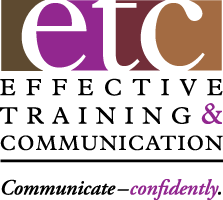A prospect recently reached out looking for help. He said he sucked at communicating at work and desperately wanted to change that. So, here’s a summary of our conversation and Action Plan strategy that might help if you think you also suck at workplace communication.
Action Step #1 – How do you know you stuck at communication? It may be a combination of self assessment, performance reviews and feedback from others Some of these factors may apply to you:
- You don’t communicate at all, especially in dealing with staff or participating in team meetings. The silent treatment doesn’t add anything to your management credibility.
- You don’t communicate enough. Less is definitely not more when communicating important messages to important people. Err on the side of over-communicating.
- You don’t communicate clearly. That you understand what you’re taking about is not enough. Your job is to ensure that people who don’t understand what you’re talking about ultimately do understand … and act accordingly.
- You don’t communicate with enthusiasm. Except for sharing bad news, effective workplace communicators sound genuinely excited about the value of the information they share, especially for the impact that information has on the listeners
- You don’t communicate with focus. Verbosity or a ‘fancy-schmancy’ vocabulary rarely work in routine workplace interactions. They quickly erode whatever level of credibility and competency you started the conversation with.
- You don’t communicate in a dialogue. Monologues may work for Shakespeare’s Hamlet, but they usually fail in workplace interactions. People don’t like to be ‘talked to’. They prefer to be ‘talked with’ instead.
Action Step #2 – Now that you know why you suck at communicating, turn the above negative ‘you don’t’ statements into positive ‘do’ statements.
- Do talk enough. Make sure you share enough of the right kind of information in the manner that works best for your listeners or readers so that they accomplish the objectives that caused you to begin talking. Continually add value to the people or processes at hand.
- Do talk clearly. Use language your listeners are comfortable hearing. Talk … or write … like a real person. Use specific language and terms. Instead of saying ‘ We’ve had a lot of comments from multiple people lately’, opt for ‘We’ve had 12 serious complaints about timely delivery from five customers in the last three days.’
- Do communicate with enthusiasm. This may be a real challenge for certain personalty styles, especially introverts. Try smiling more and using enthusiastic-sounded words. Practice so it sounds more natural. At the very least, avoid looking and sounding bored or boring.
- Do communicate with focus. Use short, simple words in a conversational structure. KISS – Keep It Short and Simple. Minimize jargon. Use effective introductions and summaries in more formal presentations.
- Do communicate in a dialogue. Invite questions all the time. Ask questions, both real and rhetorical. Minimize ‘I statements’. Instead, use more ‘We and You statements’. Check listener understanding and engagement often – ‘Does this make sense?, ‘Are we still good ?, ‘Any comments so far?”.
Action Step #3 – embrace the importance of effective, efficient and engaging workplace communication.
- Strive for continual improvement, not perfection. The marketplace can’t afford perfection. Certainly, your employer can’t. And you probably couldn’t achieve it anyway. Keep trying to exceed reasonable expectations.
- Start small. Don’t try to make all of these changes at once – you’ll burn out quick and blame me for making you do it. Pick an important improvement, work on authentic changes and evaluate results.
- Seek feedback. Explain your plan to your boss and ask for regular specific feedback. ‘Good job Bob’ is nice to hear but doesn’t help sustain improvement. Same for a trusted colleague or someone from HR or T&D.
- Engage your team. If you have staff, ask each person privately if there is anything they’d like to see different about how you communicate and why. Drill down for specifics. Then, take appropriate actions.
- Journal your efforts and results. Keep track of what you’re doing differently, how it’s working and how you know. Include regular summaries in your performance self-evaluation.
Best wishes for success as you embark on the journey that will take you to You 2.0 as a workplace communicator. You’ll experience less pain and more pleasure with routine interactions … and so will the people you interact with.
